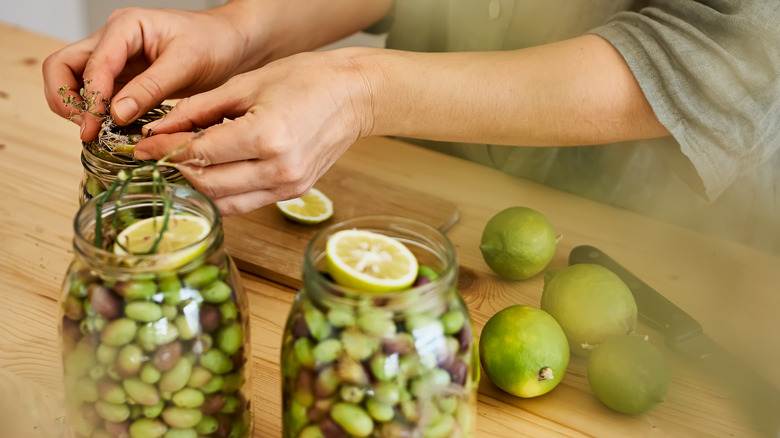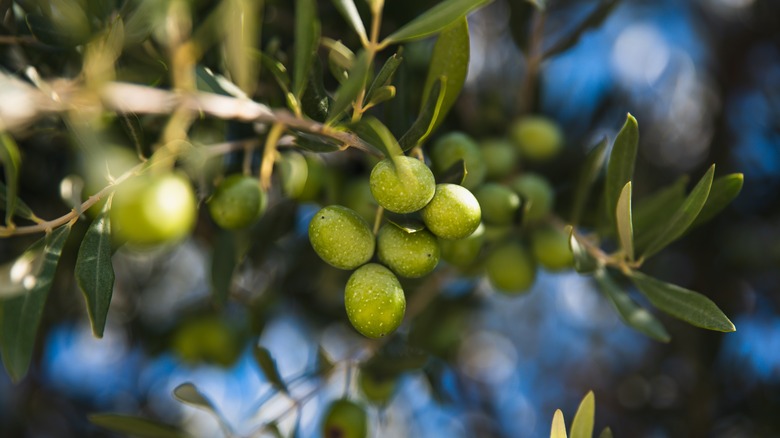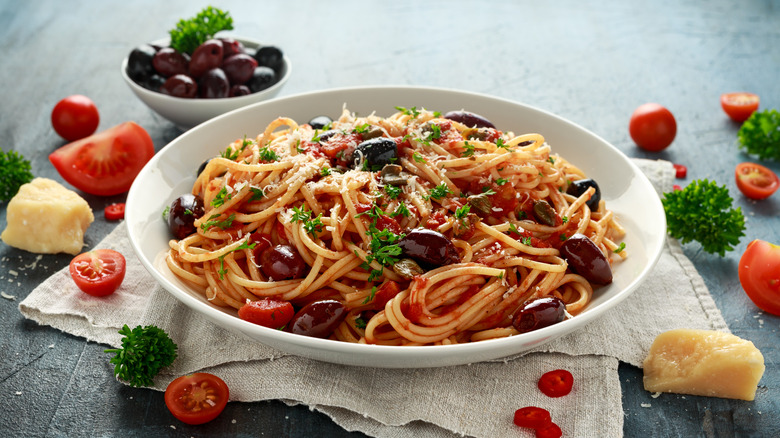The Absolute Best Uses For Olive Jar Juice
Our refrigerators and pantries are stocked, and not just with the items we primarily intend to consume. Lurking in crevasses and hidden in plain sight are a great many morsels and spoonfuls of flavorful ingredients, if you know where to look. Take, for instance, the remains of a jar of Dijon mustard. Certainly nothing can be done with those last few meager milliliters clinging to the sides, but add in your favorite oil, vinegar, and seasonings and voilà! You have a delicious vinaigrette.
Tricks such as the above are as economical as they are delicious — a way to not only stretch your dollar but to ensure perfectly good foodstuffs don't crowd the landfill or wash down the drain. The ideas are limited only by your tastes and creativity, and, let's be honest, that's why we have search engines. Leftover vegetable scraps? Use them in a broth, add them to a salad, make veggie chips, and more. Want to turn your kitchen detritus into a drink? Turn them into a boozy drink.
One of the most potent items that gets overlooked is piquant olive brine. So, how are you supposed to transform this salty, tangy juice? Let's dive a bit deeper.
From the tree to the jar
Olives are a fruit, specifically a drupe, explains Healthline. If you're a fan of peaches, mangoes, cherries, and almonds, you're a fan of drupes. But don't go picking one right off an olive tree — if you find yourself near one, that is — and taking a bite, cautions National Geographic. They are defensively bitter.
To counteract that harsh bite, olives are given a cure to draw out the bitter compound oleuropein. Science World breaks down how various curing mediums, from water to brine to lye, affect the olives. Suffice to say, water alone requires patience, while caustic, but safe-when-handled-correctly lye can dial down the bitterness in about a day.
The University of California Division of Agriculture and Natural Resources provides a more in-depth look at olive production along with recipes for everything from water-cured to salt-cured varieties. A common thread in all of the recipes is the use of pickling salt and vinegar, which is the genesis of the tangy solution filling your jar of olives.
Uses for the juice
Now that those olives have been eaten, you have a plethora of options in regards to the brine. The good folks at Bon Appétit are gaga for the stuff, referring to it as "a sneaky shortcut to acidity and depth." They suggest adding it to everything from dirty martinis — naturally — to grain bowls, vegetable soups, and pasta dishes, especially the famously-assertive pasta alla puttanesca.
On the cold side, the Washington Post has more than a few ideas. Namely, they call for swapping out a bit of the vinegar in your favorite salad dressing — have an empty Dijon jar nearby, perchance? — for a bit of briny backbone. Similarly, olive brine shines when added to bound salads, such as egg, potato, or tuna.
Last, but not least, Epicurious points us in the direction of marinades. To be fair, they are referring to any type of brine, such as pickled pepper or feta, but olive brine is squarely in the mix. Imagine how punchy Kalamata olive juice would perk up a few lamb chops, or what mild Cerignola brine could do for chicken thighs or tofu about to hit the grill.
Hopefully, this inspires you to look a little deeper at your staples. They just might be hiding a secret ready to breathe new life into your cooking.


